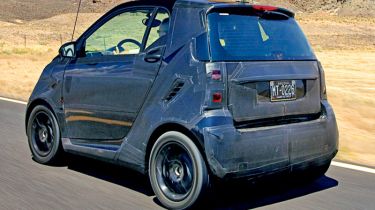Smart ForTwo
Who said good things don’t come in small packages?

The ForTwo has come of age. Engineers at the company claim it’s now better to drive, and we can confirm that the car is better to ride in. There’s no doubt that the quality is improved, too. Most impressively, though, the Smart has achieved all of this and remained true to the brand – something that eluded other, now departed cars built by the same manufacturer.
When the wraps were peeled off Smart’s all-new ForTwo for Auto Express as part of an exclusive first ride, we couldn’t believe our eyes. The newcomer, codenamed A451, is a little gem.
There is no doubt that the famous city car has grown up – but it’s done so without piling on the pounds. Engineers at the DaimlerChrysler-owned firm have kept the original model’s basic shape and cabin layout, but improved the quality and enhanced the design of virtually every component.
Both cabrios and coupés are under development, and both were with us for our journey. But as the only surviving Smarts from a line-up that once included a roadster and a four-door supermini, a lot rests on their shoulders.
There is particularly high expectation of the coupé, which will be revealed on 9 November – six months ahead of the convertible. So nothing is being left to chance. As you can see if you look carefully at our test car, there are new front lights, redesigned front and rear bumpers and an extra wide track, too.
The additions provide greater road presence, but the comfortable seats, improved safety kit and new petrol and diesel engines all take up more space. As a result, the model is 20cm longer and 9cm wider than its predecessor. That still makes it one of the smallest city cars money can buy, but somehow it doesn’t look as compact as before.
It was dwarfed by the big trucks and huge off-roaders on our American test route – although it didn’t feel out of its depth. That’s partly down to the varied engine range, which includes new 1.0-litre petrol and 800cc diesel units, both of which have three cylinders.
Jointly designed with Mitsubishi, the new petrol is available in three guises. There’s an entry-level 61bhp car and a more powerful 71bhp edition, while the flagship turbo has as much as 84bhp.
But the Mercedes-built oil-burner is the real star. The 84bhp common-rail direct-injection motor has a diesel particulate filter, and while its refinement could be better, the 60mpg we regularly saw returned was very encouraging.
The more miles we did, the clearer the benefits of the new seats and longer wheelbase became. While the current Smart is a surprisingly capable cruiser, the newcomer is more stable, and engineers report it’s easier to drive, too. The upmarket cabin is airy and spacious, and while the switchgear and instruments are covered in black tape and test gear, they look and feel far more robust.
So the Smart really has grown up; it’s now more downtown than toytown. But will this be enough to save a brand which has needed to fight harder than bosses ever thought it would for each and every sale? The answer won’t be known until the newcomer is officially launched in a few weeks.
However, our early ride has given us a glimpse of the future. And although fans of the outgoing model are sure to bemoan the increased dimensions, they will revel in the step up in quality. So it looks as though Smart is here to stay.







